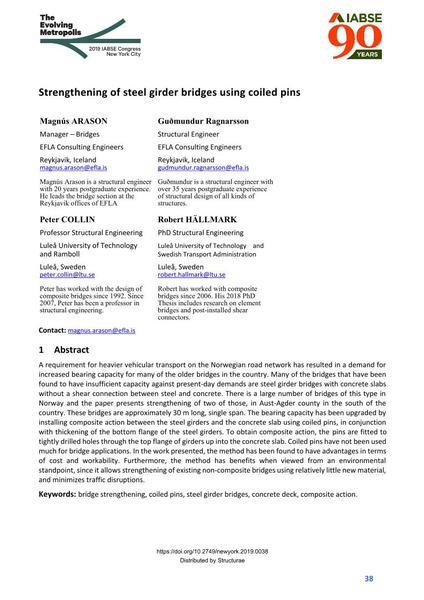Strengthening of steel girder bridges using coiled pins

|
|
|||||||||||
Bibliographic Details
| Author(s): |
Magnús Arason
(EFLA Consulting Engineers)
Guðmundur Ragnarsson (EFLA Consulting Engineers) Peter Collin (Luleå University of Technology ; Ramboll) Robert Hällmark |
||||
|---|---|---|---|---|---|
| Medium: | conference paper | ||||
| Language(s): | English | ||||
| Conference: | IABSE Congress: The Evolving Metropolis, New York, NY, USA, 4-6 September 2019 | ||||
| Published in: | The Evolving Metropolis | ||||
|
|||||
| Page(s): | 38-43 | ||||
| Total no. of pages: | 6 | ||||
| DOI: | 10.2749/newyork.2019.0038 | ||||
| Abstract: |
A requirement for heavier vehicular transport on the Norwegian road network has resulted in a demand for increased bearing capacity for many of the older bridges in the country. Many of the bridges that have been found to have insufficient capacity against present-day demands are steel girder bridges with concrete slabs without a shear connection between steel and concrete. There is a large number of bridges of this type in Norway and the paper presents strengthening of two of those, in Aust-Agder county in the south of the country. These bridges are approximately 30 m long, single span. The bearing capacity has been upgraded by installing composite action between the steel girders and the concrete slab using coiled pins, in conjunction with thickening of the bottom flange of the steel girders. To obtain composite action, the pins are fitted to tightly drilled holes through the top flange of girders up into the concrete slab. Coiled pins have not been used much for bridge applications. In the work presented, the method has been found to have advantages in terms of cost and workability. Furthermore, the method has benefits when viewed from an environmental standpoint, since it allows strengthening of existing non-composite bridges using relatively little new material, and minimizes traffic disruptions. |
||||
| Keywords: |
bridge strengthening concrete deck composite action coiled pins steel girder bridges
|
||||



